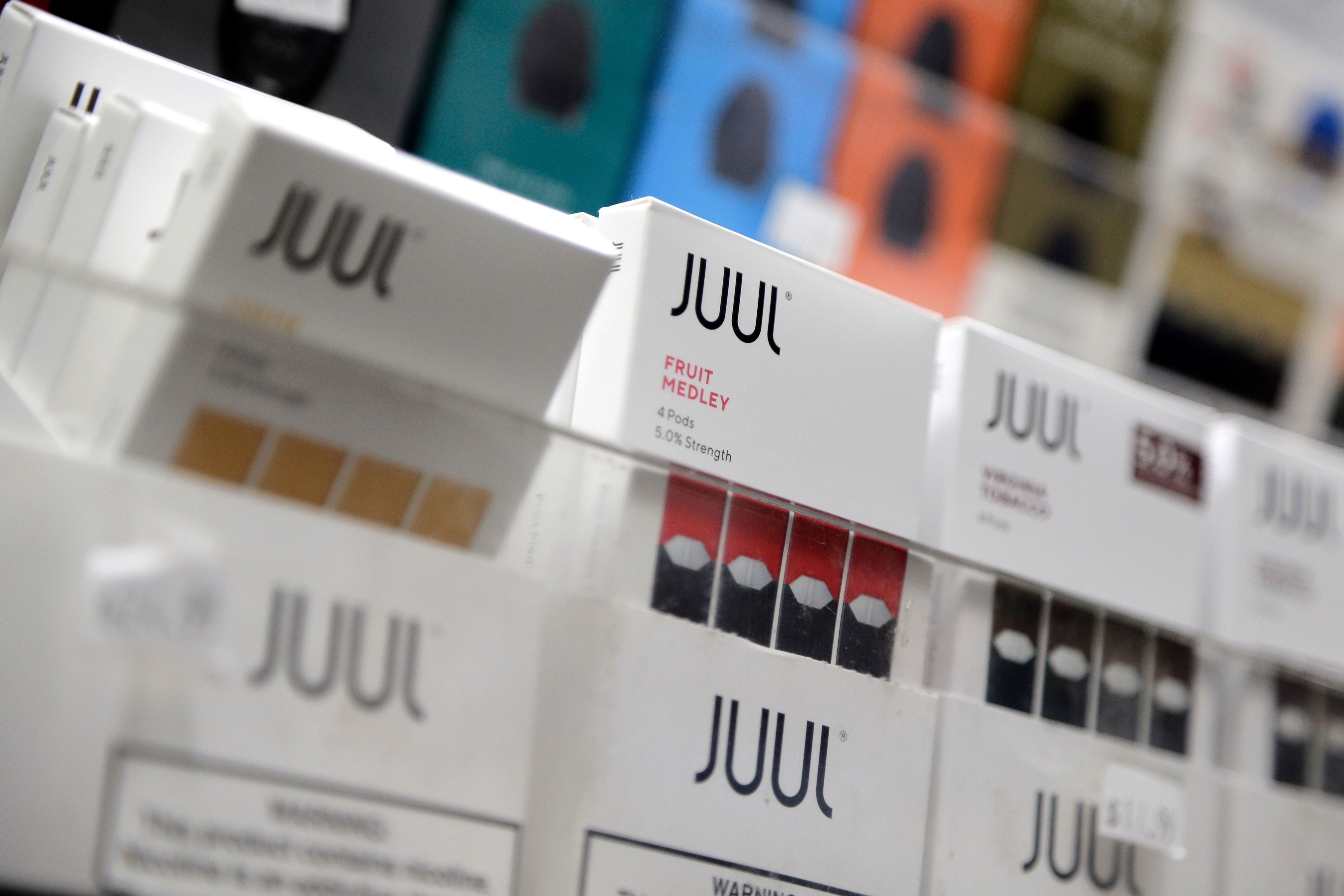BUSINESS NEWS
As Juul deals with teen vaping ‘epidemic,’ CEO tells parents I’m sorry
[ad_1]
Kevin Burns, CEO, JUUL, left, and CNBC’s Carl Quintanilla
Source: CNBC
Kevin Burns, CEO of Juul Labs — the maker of the bestselling e-cigarette in the U.S. and center of federal regulators’ crackdown into what they’re calling a teen vaping “epidemic” — has a message for parents whose children are addicted to his company’s products: “I’m sorry.”
Since launching in 2015, Juul has quickly come to dominate the e-cigarette industry with roughly 40% of the market, becoming such a dominant player that Altria, the top U.S. cigarette company, invested $12.8 billion for a 35% stake in the San Francisco-based start-up. But the company has a problem: Its vapes are incredibly popular with teenagers.
The Food and Drug Administration has declared teen vaping an “epidemic,” citing federal survey data that showed nearly 21% of high school students vaped last year. Former FDA Commissioner Scott Gottlieb and health care advocates blame the surge in teen vaping on Juul.
CNBC’s Carl Quintanilla interviewed Burns for a documentary, “Vaporized: America’s E-cigarette Addiction,” which premiers Monday at 10 p.m. ET. Quintanilla, who toured one of Juul’s manufacturing facilities in Wisconsin with Burns, asked him what he would say to a parent with a child who was addicted to Juul.
“First of all, I’d tell them that I’m sorry that their child’s using the product,” said Burns, who joined Juul in late 2017. “It’s not intended for them. I hope there was nothing that we did that made it appealing to them. As a parent of a 16-year-old, I’m sorry for them, and I have empathy for them, in terms of what the challenges they’re going through.”
The company has tried to combat youth use by shutting down its social media accounts and pulling fruity flavors like creme and mango from retailers. So far, that hasn’t stopped criticism. The company’s hometown of San Francisco banned sales of e-cigarettes last month.
E-cigarettes are being marketed to adults to help them quit smoking while still getting their nicotine fix. But they’ve come under fire in recent months for their growing popularity among teens. Federal data shows about 3 million U.S. high school students vaped last year. That is prompting fears e-cigarettes are addicting a new generation of nicotine after decades of cigarette smoking rates plummeting.
Pam Debono’s daughter Grace picked up a Juul in the summer of 2017. At the time she was 15 and Juul was starting to take off. Pam Debono calls it “the summer of Juul,” when she started finding plastic covers everywhere that she “didn’t really have a clue what they were.”
Grace told CNBC that a friend of hers bought the Juul pods and devices from a gas station. Both girls were 15 at the time. Grace said she would hit her Juul first thing in the morning and would puff on it all day, going through one nicotine pod per day — about as much nicotine as a pack of cigarettes.
“It would always be in my hands,” she said. “Like, it would always just be with me, you know? And so I would always just, like, hit it ’cause it was just so easy.”
Stanford pediatrics professor Bonnie Halpern-Felsher said her research team found kids are “more addicted” to Juul than other products because the nicotine level in Juul pods is “astronomically high.” Juul pods contain 5% nicotine, whereas other pods before Juul’s introduction contained between roughly 1% and 2.4% on average, according to the Truth Initiative, a nonprofit dedicated to eradicating tobacco. The company has since introduced lower dosages with 3% nicotine for some of its flavors.
Juul says its products are meant for adults, not minors like Grace. The company supports raising the minimum smoking age to 21 to keep teenagers from buying its e-cigarettes.
Yet Juul’s critics point to the company’s initial advertising campaign, which featured bright colors and young looking models, as evidence that Juul fueled the surge in teen vaping. Co-founder Adam Bowen said in retrospect the ads were “inappropriate.”
“When we launched Juul, we had a campaign that was arguably too kind of lifestyle-oriented, too flashy,” he said. “It lasted less than six months. It was in the early days of the product introduction. We think it had no impact on sales.”
Gottlieb, the former FDA commissioner, says the surge in teen vaping caught the FDA by surprise. While at the agency, Gottlieb delayed a key deadline that would have forced e-cigarettes to undergo FDA review by now and could have removed some from the market. He now isn’t sure if he made the right decision.
“It’s a good question [whether the delay was a mistake], and it’s a question I get all the time,” Gottlieb said. “And we struggle with it.”
The FDA review process calls for the agency to weigh the net public health benefit — meaning it needs to weigh how many adults will benefit from them versus how many teens might be harmed — when deciding whether to allow products to stay on the market.
In 2017, Gottlieb pushed the deadline to 2022 from 2018. After seeing the surge in teen use this fall, he had a change of heart. One of his last acts before stepping down in April was to move the deadline up by a year.
The courts may force the agency to work even faster. A federal judge agreed with public health groups that sued the FDA for shirking its public duty.
Some say it’s too early to judge e-cigarettes because there isn’t enough data and they haven’t been around long enough to understand the effects of long-term use.
“Frankly, we don’t know [the impact of chronic vaping] today,” Burns, the Juul CEO, said. “We have not done the long-term, longitudinal, clinical testing that we need to do.”
Despite the unknowns, some researchers say e-cigarettes could help the U.S.’ 34.3 million smokers. Regulators in the U.K. are actively encouraging smokers to give up their cigarettes in favor of e-cigarettes, while the debate in the U.S. proves far more contentious.
“Vaporized: America’s E-cigarette Addiction” airs on CNBC on Monday, July 15, at 10 p.m., Eastern time.
Disclosure: Scott Gottlieb is a CNBC contributor.
[ad_2]
Source link











